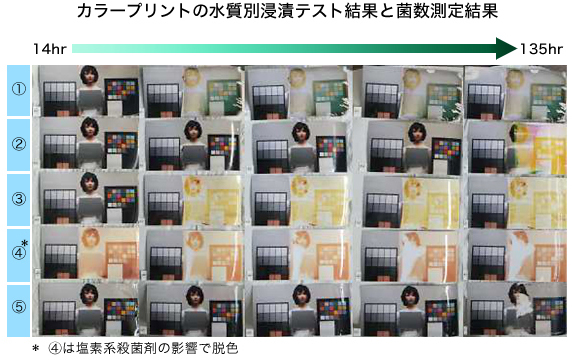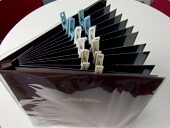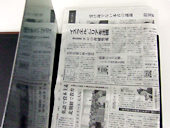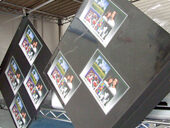Notice Regarding Special Repair Charges for Fujifilm Products Damaged by Heavy Rain from July 3, 2020
July 9, 2020
We would like to extend our deepest sympathies to all the victims of the heavy rain from July 3, 2020, and pray for the earliest possible recovery.
Fujifilm products that can be repaired by this disaster will be repaired at a special price.
Target
- Repairable Fujifilm products damaged by heavy rain from July 3, 2020
- Fujifilm products that can be repaired and are owned by customers residing in areas where the Disaster Relief Act was applied in this disaster and damaged by this disaster
Local Cabinet Office website where the Disaster Relief Act was applied due to heavy rain from July 3, 2020
Products
Digital cameras, film cameras, instant cameras, smartphone printers, digital photo albums
Special repair fee
For repairable products, we will usually pay 50% of the repair fee.
*Please contact us separately for flooding, flooding, and severe shock (burnout). Also, repair may not be possible depending on the damage situation.
* Consumption tax, cash on delivery fee, shipping fee, etc. are not applicable.
Correspondence period
December 25, 2020 (Friday) Until repair acceptance
How to request special repair
As a general rule, please attach the disaster certificate issued by a public institution (copy is possible) and request it to the following contact.
The information desk
FUJIFILM Repair Service Center 95-1
Kawakita Nakamura, Wakayanagi, Kurihara City, Miyagi Prefecture 989-5501 TEL: 050-3786-1040 FAX: 050-3786-2040
* If your photo is submerged in water, please refer to the following website and take appropriate measures to minimize deterioration of the photo.
We recommend that you take action as soon as possible so that you will not lose your precious memories.
Handling of submerged photos
To everyone affected
Don’t give up if your photo or film gets covered with water or mud. If you take appropriate measures promptly, deterioration can be minimized and important memories can be stored for a long time.
We have received inquiries from our photograph prints, photo albums, people whose films have been covered with water or mud, etc. If photos, albums, films, etc. are submerged, leaving them as they are will cause bacteria and mold to propagate and the image surface to deteriorate. Please refer to this page for general remedies for “Silver Photo Print” *1, which are mainly ordered at Fujicolor stores .
*1 A photographic print obtained by dissolving a chemical containing silver on gelatin and applying it to photographic paper, exposing it with light passing through a negative film or laser light, and then developing it. This is the name used to refer to the conventional “photograph (silver salt method)” print, in which a film or digital camera image is requested by a photo shop for printing. This is the method used by most of the photographic prints currently stored at home.
First-aid measures when photos get wet with seawater or river water
The degree of reproduction of bacteria and mold varies depending on the conditions such as water, oxygen and temperature. If you cannot wash immediately, please refer to the following measures.
First-aid measures when photos get wet with seawater or river water
Albums and silver salt photographs dipped in seawater or river water will grow molds and bacteria if left dry. The gelatin and pigments that make up the image deteriorate rapidly, and over time, the image becomes lost as if the paint had melted. In addition, if the transparent protective sheet of the album and the photos stick to each other or if the photos stick to each other and you try to peel them off forcibly, only the images may peel off, which may damage the photos.
If you cannot clean immediately, try the following measures for the time being.
1. Dry
- Let the photos dry thoroughly. Deterioration can be suppressed just by drying. For example, use clothespins and pinch one for each page of the album. Please set it so that adjacent pages do not stick together. Providing a gap facilitates drying.
- Or insert old newspapers on each page to absorb water instead of the interleaving paper. Replace old newspapers that have absorbed some moisture.
- If you can disassemble the album and divide it into pages, dry in the shade one by one.
* If the photo or film has dirt or water weeds, remove it as much as possible before it dries. After drying, you can prevent deterioration by storing in the dark at the lowest temperature.
2. Frozen
If you have a freezer, store photos and albums in a freezer as soon as they are still wet in a plastic bag with a zipper. Deterioration can be suppressed for a long time by maintaining a low temperature of about -10℃.
After that, when you are ready to wash it, immediately immerse it in tap water without thawing or drying it, and separate the photos one by one to wash.
* The above remedy is mainly for “silver print” ordered at Fujicolor shops. It does not support “inkjet printing” for home printers or “sublimation printing” for self-printing machines at stores.
* If you find a developed “negative film”, it is recommended that you keep it in a safe place without discarding it even if it is covered with water or mud. The main body (base) of “Negative Film” is plastic resin, so it is stronger than the paper of “Photo Print”. Also, since it is always in a negative case (semi-transparent protective bag), there is a possibility that it will be less damaged, and you can make photo prints again.
A common way to wash dirty photo prints and films with saltwater or river water
It is important to wash and dry as soon as possible to prevent deterioration. If you take appropriate action promptly, you can suppress deterioration of a considerable amount of photos.
What to do if your photo prints become submerged and dirty
Workaround
Always wear thin rubber gloves when working.
From the viewpoint of image condition and hygiene, gloves for nursing/medical use or food processing are recommended.
- If the photo print is completely dry, first gently wipe off any dirt on the surface with a soft brush or brush. If there is no brush or brush or the photographic print is dry (or wet), directly 2. Please start with
- Dip the photo print in water at about 20°C to 30°C (or even water at room temperature) to remove large stains. The surface is scratched, so do not rub it strongly.
- Next, soak the photo print in the clean water you prepared (same as above).
- While not scratching the surface of the photo print, use your finger pad or a brush to gently rub it in the water to gently scrub the mud and sand. Be sure to start from the surrounding areas such as the four corners, and move to the center where the main subject is located while performing the cleaning. Drops rubbed not forget the back of dirt (cleaning of the back surface, such as brush calligraphy is a convenient, efficient and, Drop dirt than finger)
* At that time, is part and around the image plane of the photographic print, If it easily turns red, yellow, or even white, the image area has been considerably damaged, so stop rubbing any further. (If the image surface is severely damaged, use thin rubber gloves. Even if you go over it, you will feel a slight sliminess when you touch it.) The image side of such prints should only be rinsed gently. - After cleaning, rinse with clean water (even cold water is possible) and dry in the shade in a dust-free place. You can spread it on newspapers, etc., or pinch the ends with something like clothespins or clips and hang it to dry. Rapid drying with a hair dryer etc. may warp the photographic print and is not recommended.
Check the video for a solution
What to do if your photo prints become submerged and dirty
https://youtu.be/pwcgC6JbCYo
* The above remedy is mainly for “silver print” ordered at Fujicolor shops. It does not support “inkjet printing” for home printers or “sublimation printing” for self-printing machines at stores.
* If you find a developed “negative film”, it is recommended that you keep it in a safe place without discarding it even if it is covered with water or mud. The main body (base) of “Negative Film” is plastic resin, so it is stronger than the paper of “Photo Print”. Also, since it is always in a negative case (semi-transparent protective bag), there is a possibility that it will be less damaged, and you can make photo prints again.
What to do if your photo prints are submerged and stuck together, or if album pages are stuck together and won’t open
Workaround
Do not try to remove it by force, and follow the steps below. To remove dirt such as mud, follow the procedure for dealing with photographic prints that are submerged and dirty .
Always wear thin rubber gloves when working.From the viewpoint of image condition and hygiene, gloves for nursing/medical use or food processing are recommended.
- Immerse the lightly washed photo prints and albums in clean water (about 20℃ to 30℃, room temperature water is also acceptable).
- Be careful not to scratch the photo prints on the surface, and slowly peel off the overlapping photo prints in order. In the case of an album, it may be possible that the surfaces of the photo prints are stuck together, so after soaking it in sufficient water, slowly peel off the album mount etc. to deal with it.
- It is essential that water is gradually penetrated into the gaps where they are attached, and that they are peeled off with care. Be prepared to ruin the album, please rescue the photo print inside. If it does not come off, do not force it, soak it in water for a while and wait for it to come off naturally. Something that sticks badly can take more than 30 minutes.
- After removing the photographic prints, rinse them with clean water (even cold water) and dry them in the shade in a dust-free place. You can spread it on newspapers, etc., or pinch the ends with something like clothespins or clips and hang it to dry. Rapid drying with a hair dryer etc. may warp the photographic print and is not recommended.
Check the video for a solution
What to do if your photo prints are submerged and stuck together
https://youtu.be/8b7nu2ndnM0
* The above remedy is mainly for “silver print” ordered at Fujicolor shops. It does not support “inkjet printing” for home printers or “sublimation printing” for self-printing machines at stores.
* If you find a developed “negative film”, it is recommended that you keep it in a safe place without discarding it even if it is covered with water or mud. The main body (base) of “Negative Film” is plastic resin, so it is stronger than the paper of “Photo Print”. Also, since it is always in a negative case (semi-transparent protective bag), there is a possibility that it will be less damaged, and you can make photo prints again.
What to do if a photo print is submerged in an album
If you leave the wet album as it is and let it dry, the photo prints inside will stick or discolor. Do not forcibly remove the photo print that has been dried completely from the mount or vinyl, and follow the procedure below. To remove dirt such as mud, follow the procedure for dealing with photographic prints that are submerged and dirty.
Always wear thin rubber gloves when working.
From the viewpoint of image condition and hygiene, gloves for nursing/medical use or food processing are recommended.
- It is expected that the photographic prints would have been wet for a long time because the pocket album and the glued type album with transparent vinyl have no escape route for water that has entered. At that time, the area around the image side of the photo print becomes red, yellow, or even whiter, and the image area is getting damaged. Especially, if the image looks like melted paint, there is a risk that the image will flow even if it is soaked in water, so wipe the dirt on the transparent vinyl before cleaning and shoot each page with a digital camera We recommend that you capture it with a scanner.
For other types of albums, it is recommended to dry before cleaning. - Disassemble the album and prepare it for cleaning.
(1) To make it easier to work, disassemble each page by cutting the album in advance. After that, remove the photos one by one with the transparent vinyl attached.
Be careful not to scratch the photo on the back side of the backing paper when using the cutter to cut out the clear vinyl. Also, if you accidentally fold the photo when removing it from the mount, the image surface may be overloaded and the photo may be damaged. Try to keep the photo as flat as possible, using a palette knife, for example.
(2) In order to protect the image side of the photo, remove the dirt on the back side of the photo and the shards and glue of the mount as much as possible with the transparent vinyl attached. Use a wet tissue to remove it.
(3) Remove the transparent vinyl from the photo.Case 1) Even through transparent vinyl, the image may be lost just by immersing it in water if the red or yellow color or the paint is melted from the periphery to the center of the photo. In that case, we recommend that you do not forcefully remove it, wipe off the dirt on the transparent vinyl, and fix it with the copy support in step 1.
Case 2) The photo can be smoothly peeled off from the transparent vinyl in the dry state, and if there is no dirt such as mud sand, the following cleaning measures are unnecessary.
Case 3) If the photo has dirt such as muddy sand even if it is removed from the transparent vinyl, proceed to 3. Washing. If it gets caught on the way, do not use force to remove it, and slowly remove it during the cleaning process. - Soak the photo (or the one with the transparent vinyl) in clean water (about 20-30°C, room temperature water is also acceptable). A large cleaning container may be required depending on the print size.
- Like the overlapping and sticking prints, slowly peel off the photographic prints from the clear vinyl and the shards of the backing that remained on the back side without scratching the surface, and rinse the taken photographic prints lightly with water.
If the photo prints are in good condition, you should be able to remove mud deposits with a quick rinse.
However, in the case of a severely damaged image, it is possible to remove a part of the image just by peeling off the transparent vinyl, so in this case it is just a work to remove the print. Never rub the image surface more than necessary or rinse it strongly. - After removing the photographic prints, rinse them with clean water (even cold water) and dry them in the shade in a dust-free place. You can spread it on newspapers, etc., or pinch the ends with something like clothespins or clips and hang it to dry. Rapid drying with a hair dryer etc. may warp the photographic print and is not recommended.
Check the video of the cleaning work soaked in water
What to do if you wash the album photo prints in water
https://youtu.be/CRPMQFIIRcM
* The above remedy is mainly for “silver print” ordered at Fujicolor shops. It does not support “inkjet printing” for home printers or “sublimation printing” for self-printing machines at stores.
* If you find a developed “negative film”, it is recommended that you keep it in a safe place without discarding it even if it is covered with water or mud. The main body (base) of “Negative Film” is plastic resin, so it is stronger than the paper of “Photo Print”. Also, since it is always in a negative case (semi-transparent protective bag), there is a possibility that it will be less damaged, and you can make photo prints again.
What to do if the color negative film is submerged and dirty
Workaround
If you find a developed negative film, do not discard it, even if it is exposed to salt water or muddy water, and collect it. Usually stored in a semi-transparent resin negative sheet, and if there is little damage, you can easily make photographic prints later. The method for cleaning mud is almost the same as for photo printing.
Always wear thin rubber gloves when working.
From the viewpoint of image condition and hygiene, gloves for nursing/medical use or food processing are recommended.
- If the negative film is completely dry with the sheet, use a soft brush or brush to gently wipe the dirt off the sheet surface. If there is no brush or brush or the film is dry (or wet), directly 2. Please start with
* The negative sheet has a long, narrow envelope shape, and there is no escape route for water that has entered, so it is likely that the negative sheet has been wet for a long time. The main purpose is to take out (or peel off) the film from the negative sheet rather than remove the mud. In that case, cut the whole negative sheet one by one with scissors in advance and soak it in water for later work efficiently. - Dip the film or the resin negative sheet with the film in water (approx. 20°C to 30°C, even room temperature water) to remove large stains. The surface is scratched, so do not rub it strongly.
- Next, soak the film or negative sheet with film in clean water (same as above).
- To avoid scratching the surface of the film, hold the parts with holes on both sides of the film, and wash the film by shaking it in water. If the film sticks to the negative sheet, soak it until it peels off naturally, and never pull it off or pull it out by force.
* At that time, if part or the periphery of the image side of the film is transparent (transparent), the image part is considerably damaged, so if you can peel off the negative sheet, be sure to remove the film. Do not rub it, hold the end and lightly rinse it with water. - After cleaning, rinse with clean water (even cold water is possible) and dry in the shade in a dust-free place. You can use the holes on both sides of the film and bend the clips through the holes to dry, or pinch the ends with something like clothespins or clips and hang them to dry. Rapid drying with a hair dryer etc. may warp the film and is not recommended.
Other measures to deal with photographic prints other than the above prints (silver photographic prints)
Workaround
The handling method varies depending on the type of photo print, so refer to the following method. Inkjet photo prints are papers that are described as photo paper or photo finishing type.
Always wear thin rubber gloves when working.
From the viewpoint of image condition and hygiene, gloves for nursing/medical use or food processing are recommended.
- For sublimation type prints (photo prints on self-printing machines at stores/FUJIFILM Quality Thermal Photo Paper on the back side of the logo), remove stains and sticking before drying. Gently wipe the front and back with a clean rag containing water. Sublimation prints do not need to be soaked in water even if they stick together, and can be easily peeled off by drying.
- In the case of ink-jet printing of dyes (home-use printers, etc.), if it is dry and one by one, clean the surface with a brush or brush. If it is not very dirty, you do not need to soak it in water, and if you want to soak it in water, work in a short time. If it sticks, it will come off in about 1 minute if you soak it in water, so please remove it from the water as soon as possible. If you leave it for a long time or rub the image surface strongly, the dye ink (pigment) may fall off and the color tends to become faint or bleed. If soaked in water, dry in the shade and dry. As the symptoms may differ depending on the type of dye ink, please contact the inkjet printer manufacturer who has the information for details.
- For pigment ink jet prints (household printers, etc.), if it is dry and one by one, clean the surface with a brush or brush like a dye. If it is extremely dirty, soak it in water and gently rub it with your finger pad or brush. If it sticks, it will come off in about 1 minute if immersed in water. Even if the image surface is dry or wet, scratching the surface may cause the ink on the image surface to peel off, so be careful. If soaked in water, dry in the shade and dry. The symptoms may vary depending on the type of pigment ink, so please contact the inkjet printer manufacturer who has the information for details.
- Be sure to wear thin rubber gloves when handling.
- From the viewpoint of image status and hygiene, gloves for nursing/medical use or food processing are recommended.
- After a certain amount of time, part of the image may be lost during cleaning.
- If it is affixed to the album, it is recommended that you wipe the dirt on the transparent protective sheet of the album before cleaning and take the whole page with a digital camera or take it in with a scanner.
- Please refer to the following pages for the flow of photo cleaning and required tools.
Flow of photo cleaning and tools
Also, this measure is provisional, and if left unattended and stored, the images may discolor. It is recommended that you consult a photo shop when it has settled down, and create a duplicate photo print that can be saved for a long time from the photo print or negative film that was dealt with.
Follow Fujiaddict on Facebook, Twitter, Instagram, and YouTube
Plus our owners’ groups
Fujifilm GFX Owners Group
Fujifilm X-H Owners Group
Fujifilm X-T Owners Group
Fujifilm X-Pro Owners Group
Fujifilm X-E Owners Group
Fujifilm X-A Owners Group
Fujifilm X100 Owners Group





